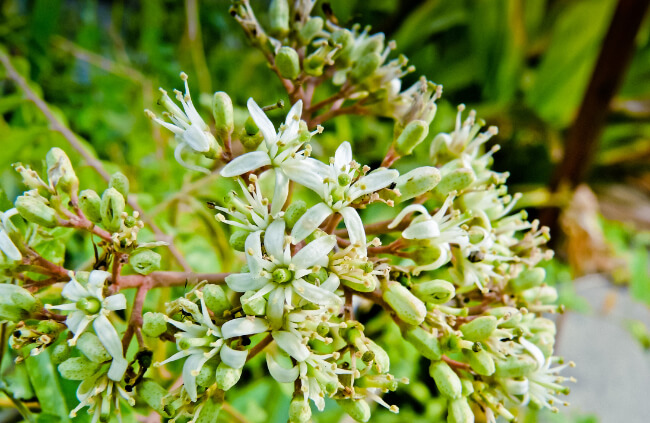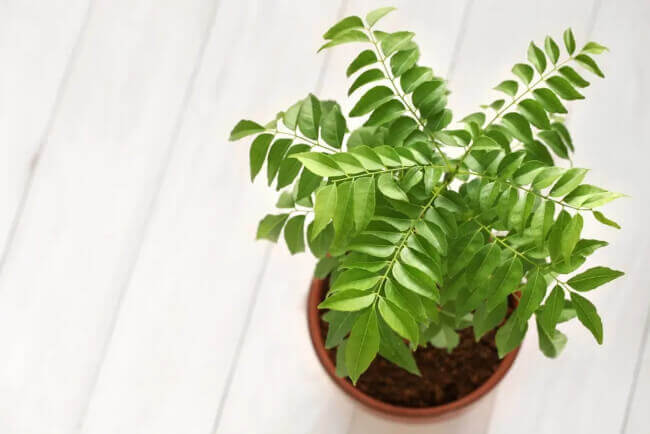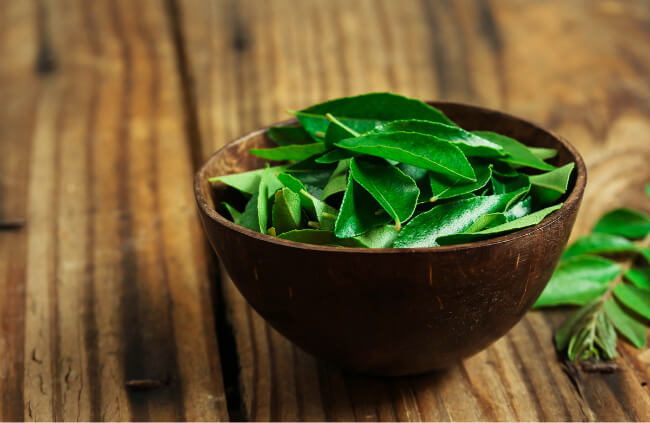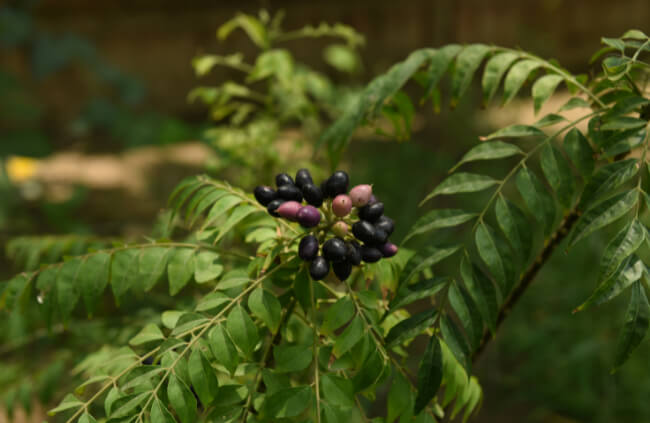The humble curry tree might not seem like an exciting addition to your garden, but its bowing branches of rustling foliage provide gorgeously filtered dappled light, stunningly unique sweet fragrance, and loads of edible leaves. There is simply nothing more useful to plant in a bright, sunny spot, than a curry leaf plant.
As well as edible uses, and ornamental benefits, curry trees are exceptionally easy to grow in most parts of Australia, but you’ll need to adapt their care depending on how hot your summers get, how cold your winters are, and your existing garden soil, but once you’ve got the planting spot sorted, they pretty much take care of themselves.
More...

Family: | Rutaceae |
|---|---|
Genus: | Murraya |
Species: | M. koenigii |
Origin: | Asia |
Common Names: | Curry tree, Sweet neem |
Location: | Outdoor |
Type: | Tree |
Growth: | 6m (H) x 6m (W) |
Sun requirements: | Full sun |
Foliage Colour: | Green |
Flower Colour: | White |
Flowering: | Summer and fall |
Fruits: | Edible berries in late summer or fall (discard toxic seeds) |
Maintenance level: | Medium-high |
Poisonous for pets: | Non-toxic to cats and dogs (other than seeds in autumn) |
What is a Curry Tree?
The curry tree, or Murraya koenigii, is a sun-loving tree that can reach 6 m tall in ten years in ideal conditions. This fast-growing tree is best known for its richly fragranced, and boldly flavoured foliage, which has been used as a culinary herb in South Asia throughout history.
While our climate differs slightly from its native space, it is easy to grow and can be grown in pots indoors, or out in the garden, but for most of Australia, is best planted out, in rich soil, in full sun, with plenty of water.

Curry Leaf Plant’s Natural Habitat
Curry trees are native to Asia, and particularly synonymous with India, where they are a staple herb, and add an iconic and authentic flavour to many dishes.
In their natural habitat, they grow in bright conditions, in moist but well-drained soil, rich in minerals. They are also well adapted to cope with droughts, extreme heat, and extreme and sudden rainfall.
Provided you never let them sit in too much water for too long, they will thrive in most Australian gardens.
How to Grow Curry Leaf Plant
Curry trees are really quite easy to grow, but it’s essential that you get their conditions right to start with. That means choosing a bright, sunny spot, on good soil, with plenty of water, but also ready drainage.
Once you’ve found a good spot, dig a hole at least twice the width and twice the depth of the root ball, and plant your tree so the top of the container soil is level with the earth. Follow the instructions below for getting the best soil mix for curry leaf plant, and then backfill the hole, before firming it in with your heel.
Leave a slight impression around the base of the tree, so it provides a reservoir for water for the first few months.
Growing Curry Leaves Outdoors
While you can grow curry trees indoors, they do best outside in Australia. If you want to grow one indoors, use the guide below, and adapt it to a container, placing your curry leaf plant in a bright window, with good ventilation and watering (and feeding) regularly to keep it happy and healthy.

Soil
Curry leaf plants like loose soil, with lots of organic matter, plenty of nutrients, and reasonable moisture retention. But finding the balance between moisture retention and good drainage can be tricky.
For sandy soils, add a bag of soil improver or organic peat-free compost to the soil to improve water retention and add nutrients. For clay soils, add sand, or grit until the soil crumbles in your hand, but still holds some moisture.
If you have a pH test kit, it’s worth using now too, as curry leaf plants do best in mildly acidic soil, with a pH of around 5.5 to 6.0. Neutral is 7, so that’s not very acidic, but it’s also slightly more than average.
If you’ve got a good spot in the garden, plant the tree, and add acidic, or alkaline composts as a mulch over the next few years, rather than rapidly amending the pH.
Light & Temperature
Curry trees are sun lovers. Plant mature or semi-mature trees (4 ft tall or more) out somewhere that they will receive 4-6 hours of sun per day as a minimum. For younger trees, it’s often worth planting them in slightly dappled shade.
As they mature they will grow up towards the light, but they will appreciate the protection from scorching Australian summers while they establish.
Water
Curry trees are quite happy to be drenched, and prefer it to a daily sprinkle, so when it comes to watering them in, use a full watering can, and for their first summer, do the same every week unless the soil is visibly damp.
Once they’ve established, leave them be, and only water during droughts, or extreme heat.
How to Propagate a Curry Tree
Curry trees, while quite easy to grow from cuttings, and from saplings, are surprisingly hard to germinate. It is possible, and there are no special tricks, it’s just about time and quantity.
Sow a good handful of seeds in a tray of moist seed compost, and leave them somewhere warm and bright, misting the soil regularly. If you’re lucky, a few will germinate and you can prick them out into bigger pots.
But, and this is important, you will get much better results by propagating curry leaf plants from cuttings.

Propagating Curry Tree from Cuttings
To propagate a curry tree from cuttings, you’ll need access to strong new growth in mid to late spring, and a bright, warm spot, without any direct sunlight.
- Start by cutting back a 10-15cm long shoot of this year’s growth.
- Fill a pot with a 50:50 mix of perlite and coir compost (no nutrients at this stage)
- Insert the cutting into the potting mix.
- Water it well.
- Cover with a plastic bag.
- Leave the cutting somewhere warm and bright, misting whenever it dries out.
- In 3-4 weeks, your curry tree cutting should have rooted.
- When roots poke out of the base of the pot, plant it into a larger container.
How to Care for Curry Leaf Plant
Caring for a curry tree is simple. Once it has established and rooted in its final position, it’s as simple as feeding when it needs it, and watering when it’s dry. Other than that, you can do as much or as little as you like, and you’ll be rewarded in equal measure.
Mulching Curry Tree
Any organic compost, leaf mould, or even part-rotted bark chips make an effective mulch for curry leaf plants. In spring, this mulch will both feed your tree and help to conserve moisture in the soil through hot summers.
Choosing the Right Fertiliser
Banana peels can be placed directly around the base of the plant to add potassium, and eggshells can be ground up to add calcium which will help to support disease resistance, but for a quick and easy cover-all fertiliser, use a simple tomato feed, or organic vegetable fertiliser to boost nutrients and add minerals to the soil once a month.
Pruning Curry Tree
For indoor growers, it’s important to cut back your curry plant regularly to stop it becoming too big, but make sure you cut back to a node, or a fork in branches to encourage new shoots.
In terms of annual pruning and care, check for signs of damage or disease regularly, and cut out any disease branches to stop the spread of infection.
How to Harvest and Store Curry Leaves
Harvesting curry leaves is easy, and can be done at any time of year. It’s best to pick full stems of leaves by cutting right back to the branch, but for an occasional harvest, you can pluck off one or two leaves and dry them quickly for tonight’s meal.

How to pick curry leaves
To pick curry leaves, you’ll need clean scissors or secateurs, and that’s about it. Just cut back a string of leaves, keeping them intact if possible, then try to process them for drying as quickly as possible.
You can do this at any time of year, but they will have the deepest flavour in summer.
Drying curry leaves
Drying curry leaves for storage is quick and easy. Start by washing the leaves thoroughly with tap water, and patting them dry with a clean kitchen cloth. After that, you can either dry them in the oven or on a line.
Oven drying is faster, but they won’t store as well and can lose flavour. Line drying is slower, but preserves flavour and prolongs storage. To oven dry, place your washed leaves in a low oven for about 5 minutes, then leave them to cool slowly with the door open.
To line dry and preserve maximum flavour, place washed leaves (still on their stem) on a washing line, in full sun for 2-3 days until they are crisp and crumble when you squeeze them.
After both methods, add them to an airtight jar, and place them in a cool, dark and dry place until you need them.
Curry Leaf Plant Pests and Diseases
Curry trees are also known as Sweet Neem, but unlike true Neem trees, they have very little resistance to pests, and can actively attract them.
Common pests like aphids, mealybugs, and spider mites can infest new shoots in spring, so keep an eye out for them, and they will suck away the sap which can damage the tree as well as reduce the flavour of your harvest.
Treat any infestations with cold-pressed neem oil early in the morning before bees and pollinators are active to reduce harm to wildlife.
Fungal and bacterial infections are not common with curry trees, but pests can spread leaf spots (bacterial and fungal), and root rot is quick to take hold in damp conditions.
If you suspect fungal root infections (drooping yellow leaves, or discoloured shoots paired with damp soil is a clear sign) then stop watering and treat the soil with a copper-based fungicide.
If the problem persists, dig the plant up and check the roots, or dig down to the root and check for signs of damage or disease.
Curry Tree Frequently Asked Questions

Can you grow a curry tree in Australia?
You can grow a curry tree in Australia with not much effort at all, but make sure you’ve got the right conditions first. For example, if you’re in a cooler part of the country, particularly if there is a risk of winter frost, you’ll need to grow it indoors.
Is a curry plant the same as a curry tree?
Curry plants (Helichrysum italicum) and curry trees (Murraya koenigii) are different plants, but the curry tree is often referred to as a curry plant. Both names are fine, and no one will be offended, but for clarity, it’s worth thinking of the curry plant and the low-growing herb.
What’s the best fertiliser for curry trees?
Curry trees are hungry plants, so they need balanced nutrients as well as basic minerals like calcium. The best fertiliser for curry trees is any organic balanced feed, like liquid seaweed or tomato fertiliser.
Wrapping Up Our Curry Tree Guide
A curry leaf plant is a crop as much as it is an ornamental plant, but it’s important to remember that both go hand in hand with these beautiful trees. For best results, treat your curry tree as both, so it’s pruned for beauty, but with enough foliage to harvest without limiting its development.
Once you’ve planted a curry tree in your garden, wait for two years before your first harvest so it can make the most of every single leaf to provide energy and sugars and drive root growth, new shoots, and development. Do that, and you’ll grow your own curry tree in no time at all.
Published on June 3, 2023 by Maisie Blevins
Last Updated on February 23, 2024




